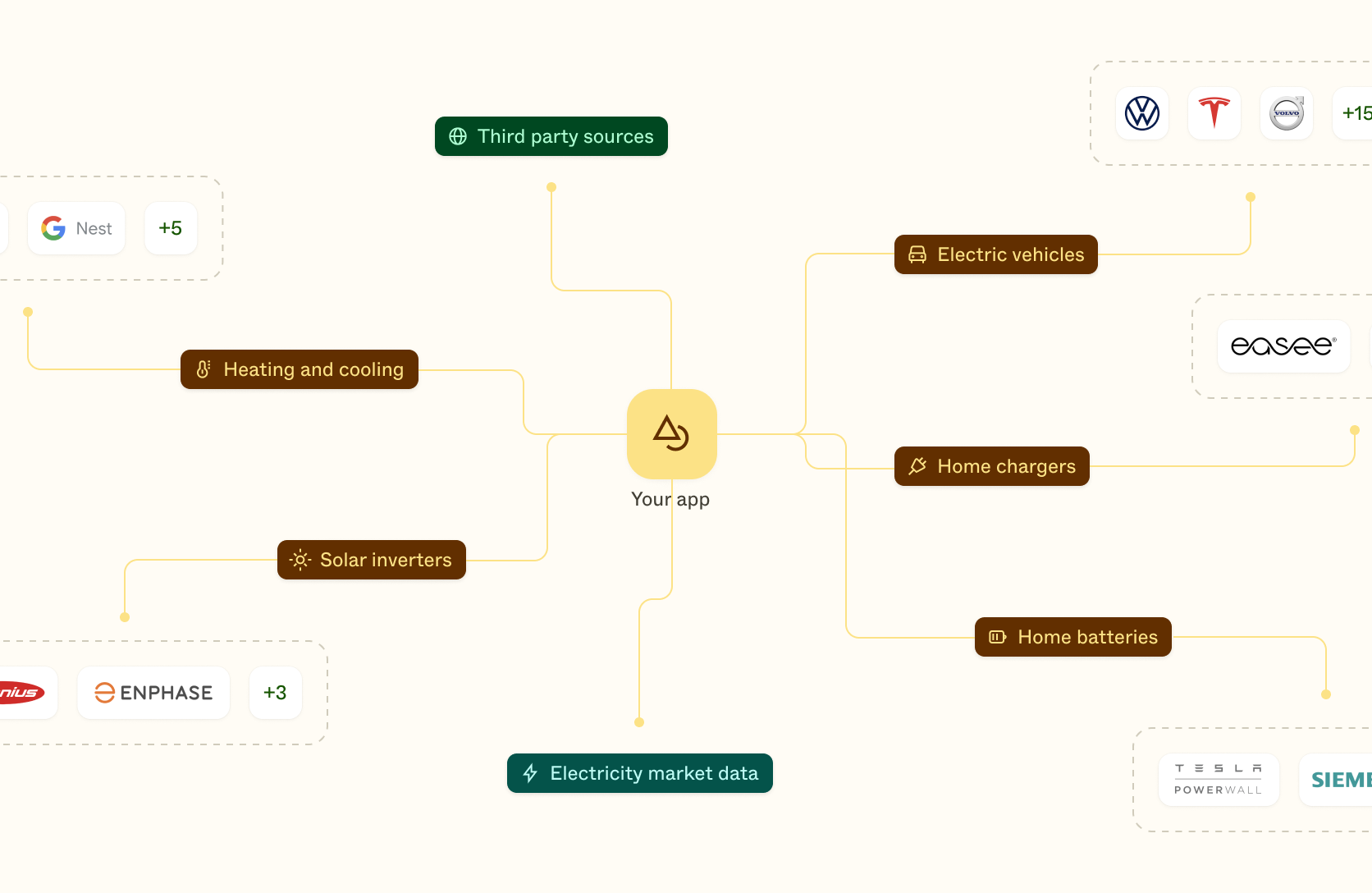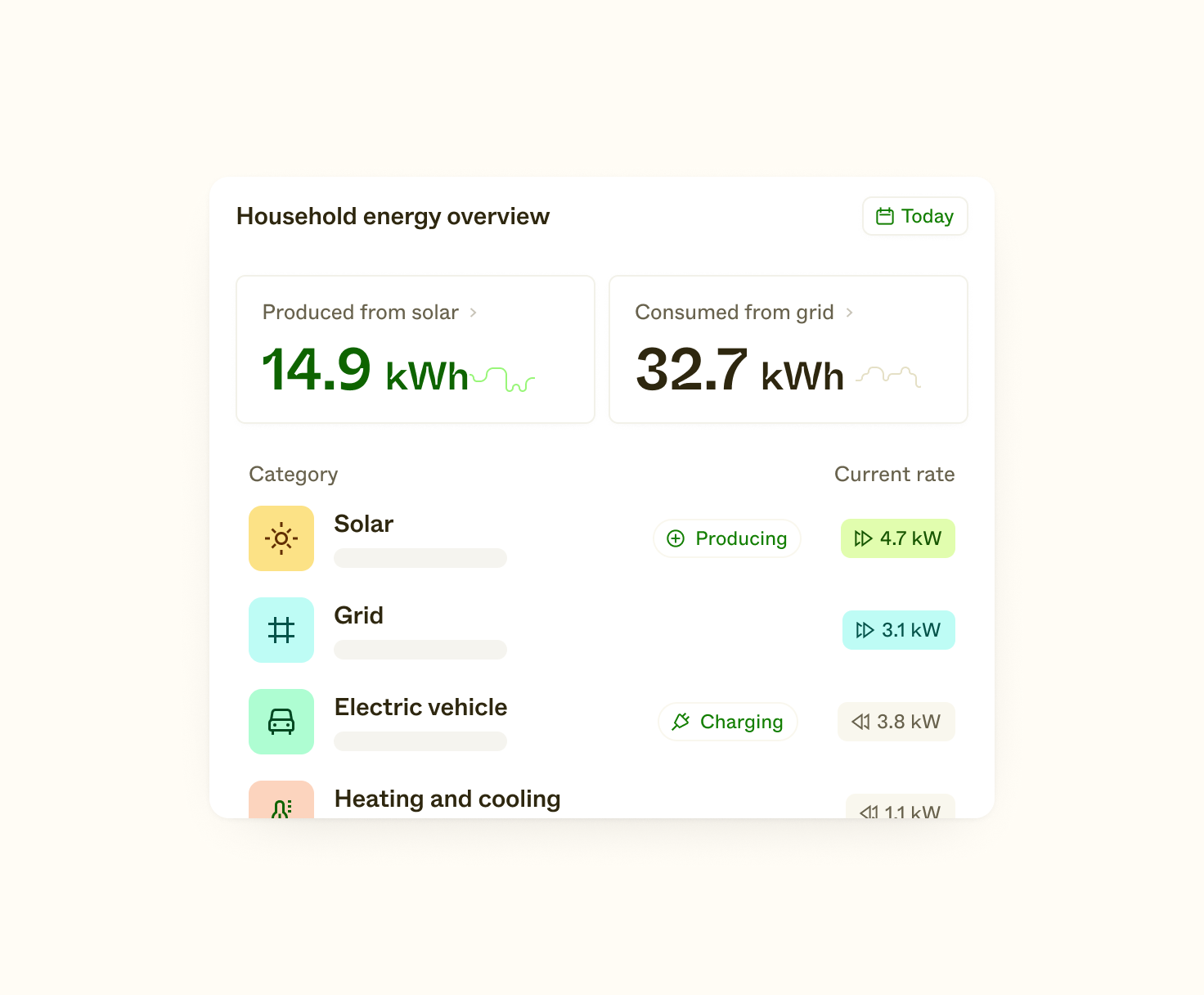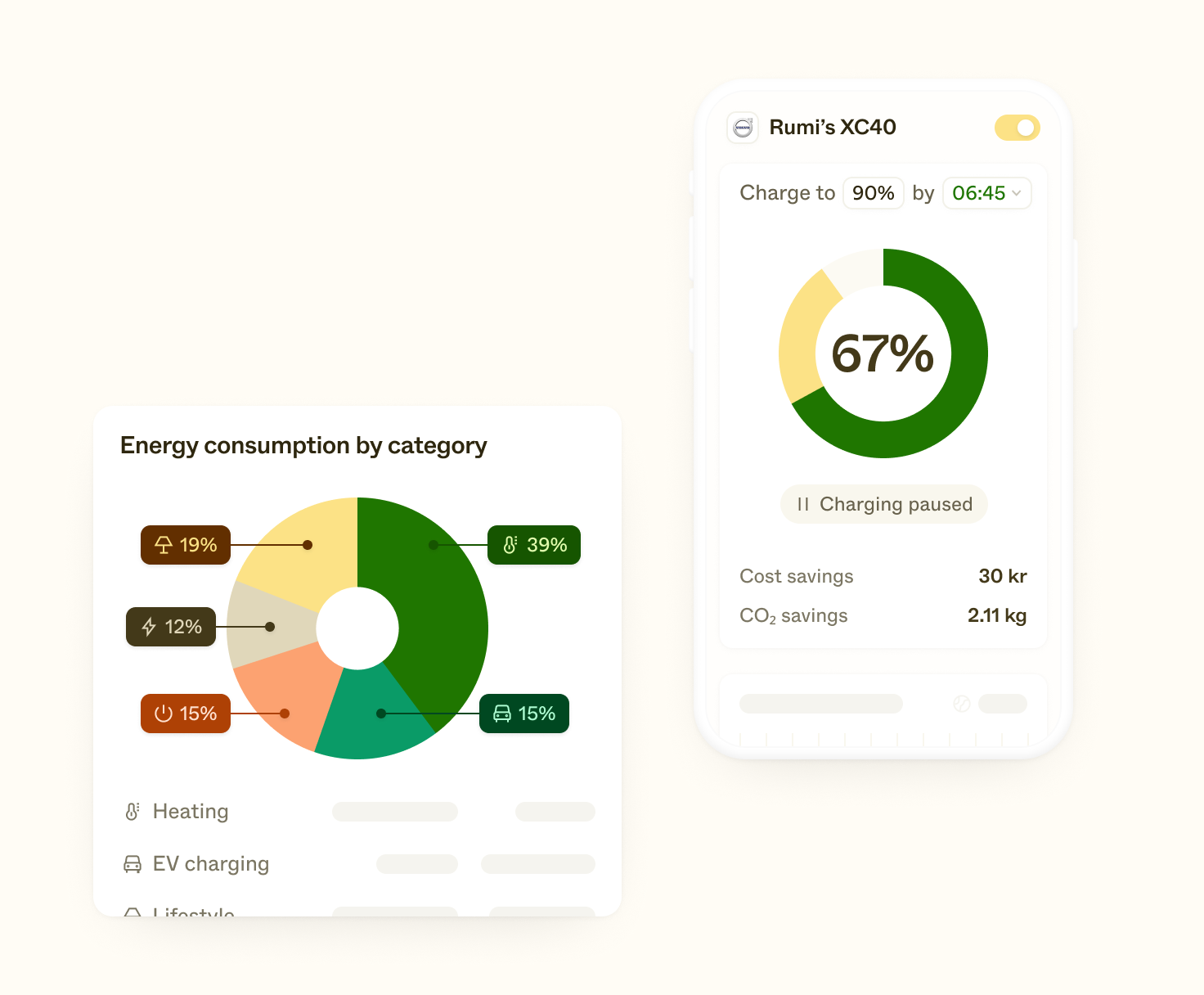A complete guide to Distributed Energy Resources (DERs) and their role in a sustainable future

Electric vehicles, smart thermostats, residential solar, and home batteries. More and more of us are getting them and they are all part of our sustainable energy future. Wish there was a good collective word for these things…
And there is! Distributed Energy Resources, or DERs for short, is an acronym to learn right away. Not just because you will own a lot of DERs in the future if you are not already. But because they can accelerate the transition to renewable energy. How? That is exactly the topic of this article.
To give you a short summary, these DERs can be bundled together into something called Virtual Power Plants (VPPs). These VPPs can again be used in the Demand Response market, to balance the grid and increase the mix of renewable energy.
In this guide, we will give you a full deep-dive into distributed energy resources. What they are, how they work, and their role in a zero-carbon energy system.
More specifically we will cover:
- What is a Distributed Energy Resource (DER)?
- How Distributed Energy Resources (DERs) can help save the planet
- The key types of Distributed Energy Resources (DERs)
- What do DERs have to do with Virtual Power Plants?
- What do DERs have to do with demand response?
- Leading players in the DER space
- How can my company engage customers with DER apps and service?
What is a Distributed Energy Resource (DER)?
A Distributed Energy Resource (DER) is a hardware device that consumes or produces electricity. DERs are usually “behind-the-meter” devices like electric vehicles, smart thermostats, home batteries and solar inverters. This category of energy hardware is growing exponentially in many markets, making it important for the future energy system.
Distributed energy resources (DERs) can come in many forms, and encompass a wide range of technologies, but are defined by their proximity on the grid to their point of use. In other words, instead of generating electricity, transmitting that electricity, over miles of power lines, to the final point of consumption, DERs tend to generate electricity in very near proximity to where that electricity will be consumed.
Traditionally, DERs were thought of as assets that produced electricity, such as solar, wind, and combined heat and power (CHP) technologies. However, more recently, as technology has developed and the grid has become more dynamic, DERs have expanded to include assets that can help balance and control demand on the grid. This includes thermostats, EVs, batteries, and hot water heaters. In fact, as technology continues to advance, the list of technologies that are able to function as DERs is certain to grow.
How Distributed Energy Resources (DERs) can help save the planet
DERs allow for the grid to become both more resilient and reliable. Because the electricity is being produced near the point at which it is being used, DERs do not waste energy through line loss over long transmission lines. This mean more of the energy which is produced will be used. DERs are also sometimes known as non-wires alternatives or NWAs. NWAs are very important as utilities transition to renewable energy resources. These resources are more flexible, and are often solar, batteries, EVs, and other demand-side management tools.
More renewable energy
As talked about above, DERs tend to be solar, batteries, EVs, and other renewable energy resources. These flexible renewable energy resources are able to be added to the grid very easily and inexpensively. Integrating more DERs onto the grid means that fossil fueled power plants do not need to be built, or run as frequently. Small scale solar and wind DERs will play an important role in the energy transition.
More stable grid
Stability is the most important aspect of every electricity grid. In order to have a stable grid, an enormous amount of innovation, technology, and human capital has been deployed over the past 80 years. The electricity grid is one of the greatest achievements in modern time. However, as the energy transition continues to evolve and more renewable energy, and electrification occurs, more innovation will be necessary. DERs are enormously important because they are so flexible. DERs also provide reliability and resiliency because they are located so close to their point of use, instead of relying on miles of transmission wires and cables. If a tree falls and knocks out a transmission or distribution line, there are many homes and businesses which will be impacted. However, is energy generation is distributed throughout various resources on the grid, the grid is much more stable.
The key types of Distributed Energy Resources (DERs)
Electric vehicles
EVs are an important and growing DER category. EVs as a DER asset is made even more exciting as technological changes are combined with regulatory changes, empowering the EV to be perhaps the most important resource in the new electricity grid. The flexibility of EVs allows them to absorb excess generation from renewable energy resources, as well as act as real-time demand response assets.
EVs are effectively a movable grid resource. Smart charging, which empowers EVs to charge only when there is excess supply on the grid or prices are inexpensive, allows for EVs to act as a dynamic DER asset in time. This ability to respond, in real time, to fluctuations of both supply and demand, make EVs a powerful DER and a key asset in the energy transition.
Most EVs can be controlled via an electric vehicle API to become a smart DER.
Thermostats
Smart thermostats are growing in popularity. Thermostats are increasingly thought of as DERs because of their ability to help the grid become more stable during periods of instability or peak usage.
Connected thermostats are able to remotely, or automatically, change their set points to either pre-cool or pre-heat homes and facilities so energy users don’t have to use energy during periods of high prices. Most thermostats can be controlled via a thermostat API to become a controllable load.
Thermostats are also able to react in real-time and curtail the usage of HVAC systems to reduce the energy load and profile of customers during periods of grid instability. This ability for thermostats to act as a grid resource is an important feature of all DERs.
EV Chargers
EV chargers play an important role as DERs, helping utilities and aggregators understand how many EVs are plugged in and whether or not those EVs can help stabilize the grid. EVs chargers can stop the charging of connected EVs during peak periods, can wait to charge connected EVs until energy is abundant and prices are low, and some can even inject additional energy into the grid via V2G.
Solar and batteries
Solar and batteries are both DERs, which work independently and together to help balance and stabilize the grid. Solar produces energy near where it will be consumed, which reduces the need to produce energy at large centralized power plants, often with dirty fossil fuels, and transport it miles to the same endpoint. Batteries are able to store excess energy, when there is an abundance of energy and prices are cheap, and dispatch that same energy when energy is scarce and prices are high. Solar plus battery storage is a powerful combination of DERs, which will allow more resiliency and reliability on the grid.

What do DERs have to do with Virtual Power Plants?
Virtual power plants are new idea. At their core, VPPs are a group, or aggregation, of DERs which can be controlled remotely as a group but continue to operate independently. Effectively, VPPs are a group of DERs that can be single type of asset, such as EVs, or can be comprised of a heterogeneous mix of assets, such as batteries, EVs, CHP facilities. The DERs which make up the VPP are all connected to the grid and operate independently, on their own, outside of the VPP. Finally, VPPs are dispatched from a central control. VPPs ability to dispatch DERs to provide grid flexibility is a key aspect to resiliency and reliability.
What do DERs have to do with demand response?
Demand Response (DR) is a reliability tool that helps reduce stress on the utility grid during peak periods of time. Traditionally, large commercial and industrial customers were participants in DR events, because they can curtail such a large amount of energy all at once. However, as technology has improved, more and more DERs can participate in DR events. DERs participate in DR events in a variety of ways. Thermostats can raise their set point, EVs can stop charging, and batteries can dispatch their stored energy to keep the facility running. Demand response programs are increasing including more DERs.
Leading players in the DER space
Large corporates
Enel X is one of the most experienced players in the DER market. Enel X installs batteries, and with the launch of Enel X Way they also have a huge push for smart charging. If you are looking to run your own DR program or want to participate in one as an energy hardware owner, Enel X is a company to talk to.
You can read more about their offerings here.
Voltus is a leading demand response provider in North America, and working to become a platform for DERs. They operate in each and every deregulated wholesale market where demand response exists. They are a new company but have grown rapidly over the past five years and have customers in throughout North America. Voltus’ focus on technology has allowed them to enroll large industrial customers into fast response and high-frequency demand response programs.
You can learn more about their offerings here.
Startups
Leap is a relatively new company participating in demand response markets. Leap’s customers participate in both commercial and residential demand response programs. In addition, Leap is a software-focused company that is working to build a platform for all DERs to participate in both demand response, as well as respond to price signals.
You can read more about their offerings here.
Enode
Having worked on connections to DERs for several years now, we at Enode have a full range of connections for electric vehicles, thermostats, heat pumps and more. We also provide additional demand response and VPP products for companies that have DERs connected through our platform.
You can learn more about the Enode Energy API here.
How can my company engage customers with DER apps and service?
Smart charging
Smart charging apps help consumers control when their EV will charge. Without smart charging, EVs will simply start to charge when plugged into a charger. With smart charging, charging will not begin until energy is abundant and inexpensive. This typically happens in the night hours and often utilities have what are known as Time of Use rates, which incentivize charging during these off peak periods by making energy even cheaper than it typically is. Smart charging can also respond to price signals in the energy market. Meaning if the price of energy goes above a certain price, or below a certain price, the EV will either stop charging or start charging again. Smart charging is a powerful tool to help customers save money as well as save energy. Smart charging is an important opportunity to turn a DER, such as an EV, into a powerful resource on the grid.
Smart heating and cooling
Smart cooling, as a DER, works in a very similar manner as smart charging, except with connected thermostats. Thermostats on their own do not reduce or increase energy usage; however, the heating and cooling equipment they control have large energy profiles. Smart heating and cooling will predict, in advance, when their will be a peak energy day and will implement pre-cooling or heating. Pre-cooling is where the thermostat will signal to the equipment to cool in the early hours of the morning, which cools the ambient temperature in the facility before the peak energy period occurs. This allows the consumer to pay less, and the grid experience less strain.
Energy data and insights
Energy data is a powerful tool to help understand customer behavior and plan for more efficient energy usage. Load profiles, or when a customer uses how much energy, help companies understand where they might be more efficient. For example, often industrial companies will have a large spike of energy when a shift starts and all of the machinery is started simultaneously. This large spike of energy can be detrimental to the customer and cost them an unnecessary amount of money. Instead, if the same customer staggered the start of those same machines over a 15 or 30 minute period, they could save a significant amount of money. Energy data and insights allow companies to understand their load profile and look for possible improvements. This type of energy management service is made possible with DER connections.

How can I use my own DERs to accelerate the transition to renewable energy?
DERs are a powerful tool to help accelerate the energy transition. Using your own DER can be both fun and effective! Installing solar will allow you to produce clean and renewable energy, which you can use at your home. If you install a battery, you will be able to store energy that is created during the middle of the day, when energy is cheap and abundant, and use that same energy in the evening, when energy is scarce and expensive. Driving an EV also helps accelerate the energy transition. Your EV can be a flexible DER asset, helping give the grid relief wherever you may be charging!
Smart EV charging apps
Smart EV charging apps are a great way to ensure your EV is the most effective DER asset it can be. When you enable smart charging you are enabling the grid to only supply your EV when energy is inexpensive and plentiful. This is an enormous tool, and one that every person can take. Smart charging allows everyone to participate in the energy transition!
Utility programs
Utilities have many different DER programs, and often will offer incentives to purchase a DER. Nearly every utility has implemented incentives to utilize your DER as a grid asset. Be sure to check with your local utility to see how you can get involved and start becoming part of the energy transition!
How to learn more about Distributed Energy Resources (DERs)?
To learn more about DERs we recommend talking to other experts in the industry. Some of the companies mentioned in this article will be able to add even context when you are diving into the subject.
We have also gathered some additional DER resources that are worth looking into:
- A full guide to DERMS
- A full guide to demand response software, a logical next step from VPPs
- This The Verge video on virtual power plants in cities.
